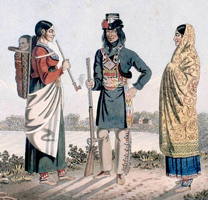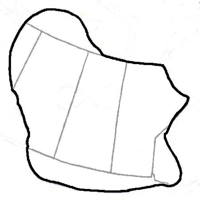
|
The Society of Folk Dance Historians (SFDH) Métis
[
Home |
About |
Encyclopedia | CLICK AN IMAGE TO ENLARGE |

|
 Canada has a founding people who once traversed North America's interior in Red River carts, hunted bison with military precision, danced and jigged to spirited fiddle rhythms, wore brightly adorned embroidered clothing as well as sashes or shawls, spoke their own unique language, prayed to the Bon Dieu/Kitchi-Manitou and to their patron saint, St. Joseph, and even had their own werewolf. These people were the Métis. As the word was known at the time of contact, "métis" or "méstis," means "mixed" in French. From méstis evolved méchif and mitchif or Michif, the name of a language, a culture, and a people within the Métis nation. The epistemological roots of the word "Métis" are very important because the word presently denotes a distinct Indigenous nation with a talent for adopting other cultural traditions and making them their own. Indeed, the Métis have always practiced a culture which has fused First Nations (Cree, Saulteaux, Dene, and Dakota), Euro-Canadian (Canadien), and European (Scots/Orkney) parent cultures into a unique synthesis.
Canada has a founding people who once traversed North America's interior in Red River carts, hunted bison with military precision, danced and jigged to spirited fiddle rhythms, wore brightly adorned embroidered clothing as well as sashes or shawls, spoke their own unique language, prayed to the Bon Dieu/Kitchi-Manitou and to their patron saint, St. Joseph, and even had their own werewolf. These people were the Métis. As the word was known at the time of contact, "métis" or "méstis," means "mixed" in French. From méstis evolved méchif and mitchif or Michif, the name of a language, a culture, and a people within the Métis nation. The epistemological roots of the word "Métis" are very important because the word presently denotes a distinct Indigenous nation with a talent for adopting other cultural traditions and making them their own. Indeed, the Métis have always practiced a culture which has fused First Nations (Cree, Saulteaux, Dene, and Dakota), Euro-Canadian (Canadien), and European (Scots/Orkney) parent cultures into a unique synthesis.
Métis people in Canada are specific cultural communities who trace their descent to First Nations and European settlers, primarily the French, in the early decades of the colonisation of the Canada. Métis peoples are recognized as one of Canada's aboriginal peoples under the Constitution Act of 1982, along with First Nations and Inuit peoples.
While the Métis initially developed as the mixed-race descendants of early unions between First Nations and colonial-era European settlers (usually Indigenous women and French settler men), within generations (particularly in central and western Canada), a distinct Métis culture developed.
Métis Elders or "Old People" have always transmitted cultural knowledge to younger generations through oral tradition. From this oral tradition emerged a rich storytelling culture that blended various First Nations motifs, such as the tricksters Wisahkecahk and Nanbush, with French-Canadian ones, such as Chi-Jean (from Ti-Jean), le diable (the Devil as a dog or handsome stranger), and le rou garou (from loup garou, a werewolf), a person who fell out of the Creator's favor.
After New France was ceded to Great Britain's control in 1763, there was an important distinction between French Métis born of francophone voyageur fathers and the Anglo-Métis (known as "country born" or Mixed Bloods, for instance in the 1870 census of Manitoba) descended from English or Scottish fathers. Today these two cultures have essentially coalesced into location-specific Métis traditions.
Traditionally, the Métis were very spiritual: most practiced a folk Catholicism that was rooted in veneration of the Virgin and based on pilgrimages such as those to St. Laurent de Grandin (near present-day Duck Lake). It involved holding wakes for departed loved ones, sprinkling holy water during menacing thunderstorms, providing thanks to the Creator by offering tobacco, and ensuring that Christmas and Lent were strictly periods of spiritual reflection devoid of celebration or materialism.
The Métis style of dancing to fiddle tunes was very similar to their Celtic and French-Canadian antecedents, but seamlessly weaved in faster-paced First Nations footwork and rhythms such as in traditional drumming. These traditions vary among families and communities: for instance, the Red River Jig, the signature fiddle tune and dance of the Métis, has many different versions and step patterns. House parties, focusing on jigging, dancing, and fiddle playing, were a constant feature throughout Métis history, the climax of revelry being the réveillon (New Years' Eve). During such times of celebration, Métis women prepared a feast that included les beignes (fried bread), la galette (bannock), les boulettes (meatballs), le rababou (stew), and molasses cakes.
The Métis are also heirs of a vibrant material culture which emphasized the floral motif in bead, quill work and embroidery. After adapting the design from the Grey Nuns in the 1810s, generations of Métis women produced countless objets d'art for their loved ones, for decoration, and for sale to non-indigenous collectors.
Closely related are the Métis in the United States, primarily those in border areas such as Northern Michigan, the Red River Valley, and Eastern Montana.
DOCUMENTS
- Canada, a country.
- Métis Dancing, an article.
Printed in Folk Dance Problem Solver, 2001.
This page © 2018 by Ron Houston.
Please do not copy any part of this page without including this copyright notice.
Please do not copy small portions out of context.
Please do not copy large portions without permission from Ron Houston.